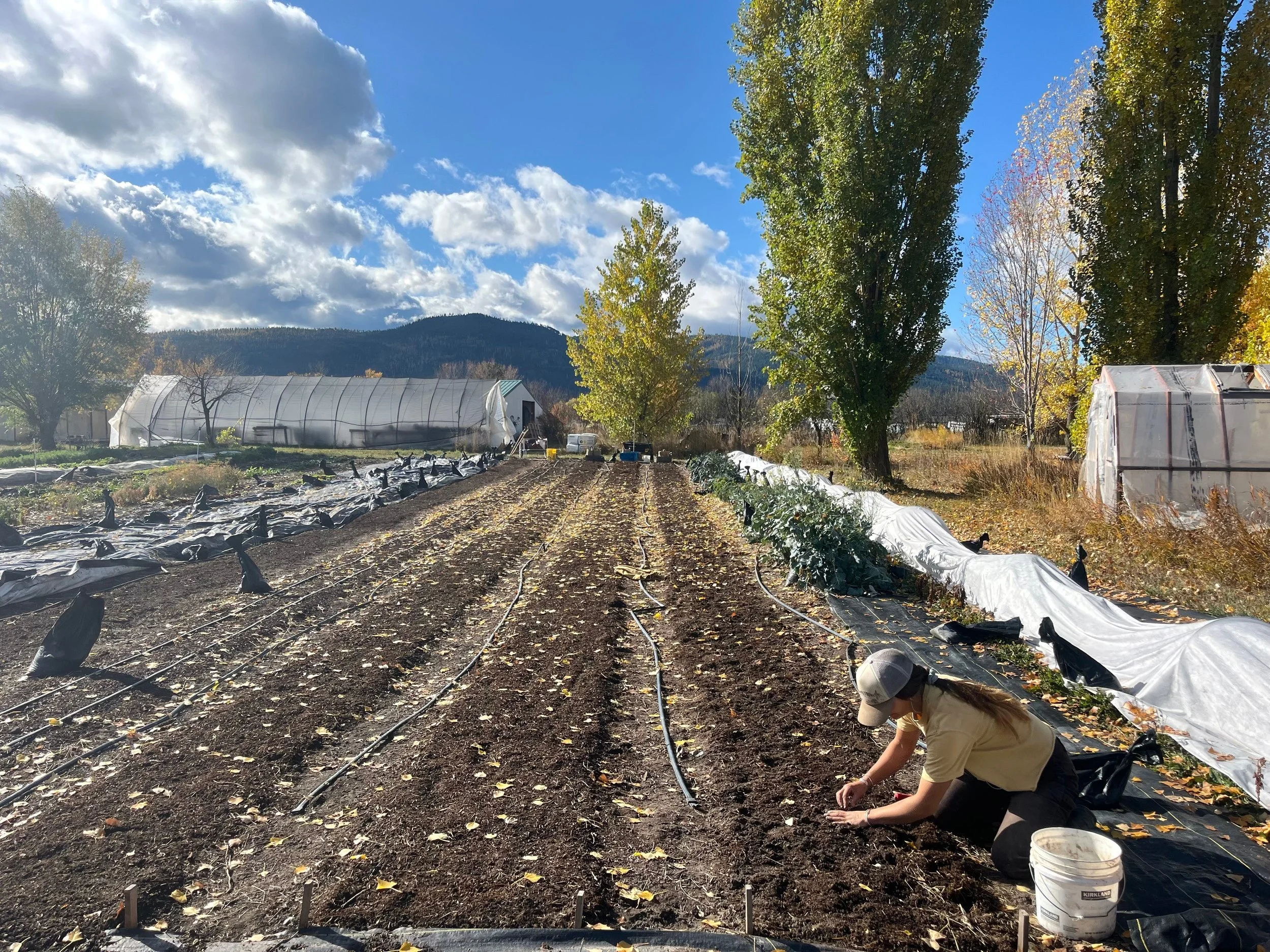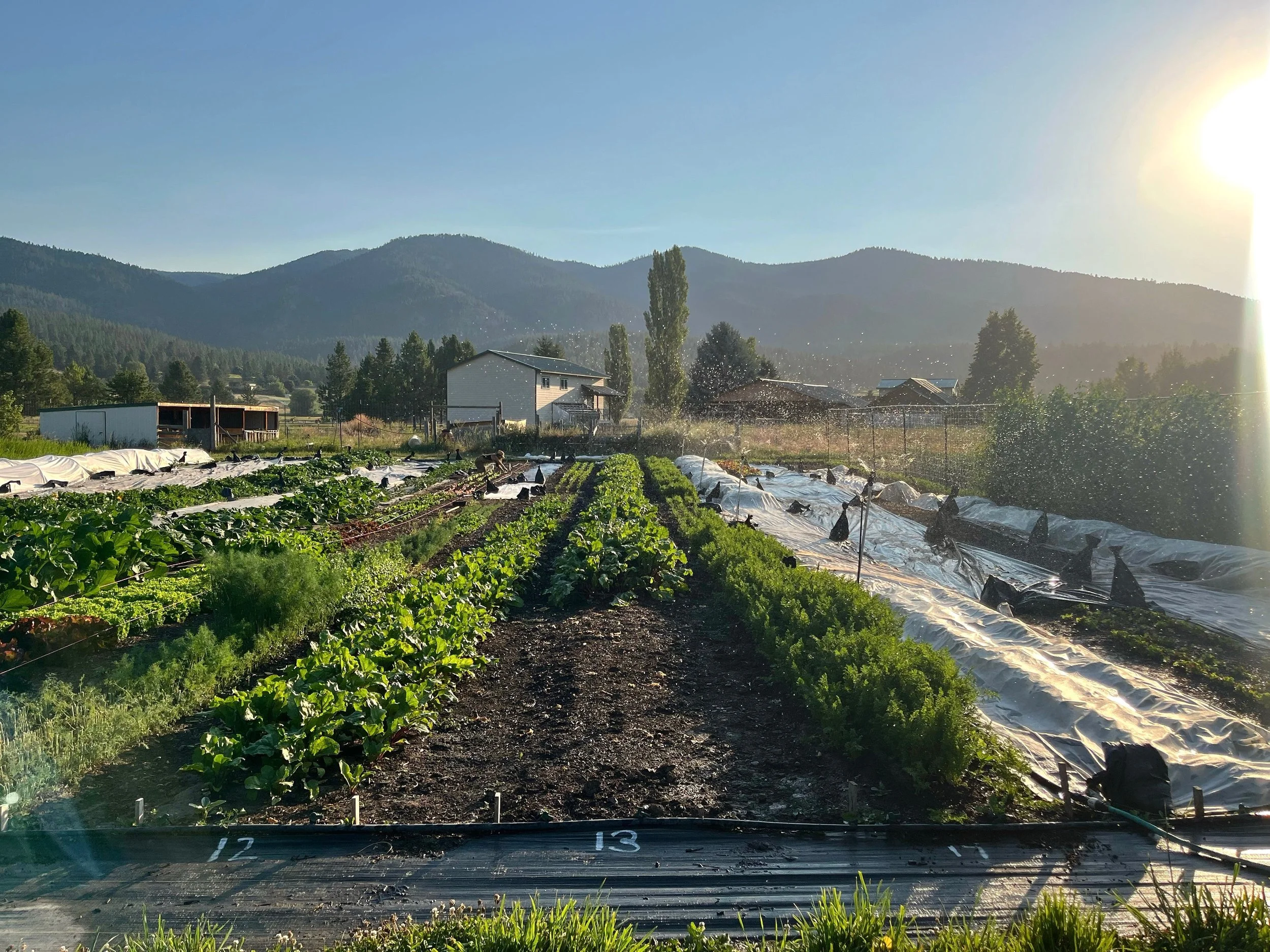No-till, what the kale?
This blog post was written by Kitty Galloway, former Northside Community Gardener and co-owner of Long Step Farm, which is a small, certified organic veggie, herb and flower farm in Frenchtown, Montana. Like many organic growers, they are serious about soil health and supporting ecological balance. However, perhaps more unique to their farm in western Montana, they strictly focus on no-till farming.
As Kitty said, “For those of you who don’t know, ‘no-till’ on its surface refers to a method of cultivation or bed preparation, in other words, what a grower does to a space to get it ready to plant. No-till as a practice is a little bit of a confusing place - there’s no one specific definition or certification for it...This leads to it meaning a lot of different things to different people.”
Even at Garden City Harvest, our farmers call their practices “low-till” or “conservation tillage.” So I had to ask Kitty, “What do you mean by no-till ? Like really, what does it look like day to day on your farm?” Kitty is a writer and educator with her masters in Environmental Writing from University of Montana, so here’s her simple response.
Author, Kitty Galloway, and her daughter have a moment in the field at Long Step Farm. As part of their no-till practice, Long Step grows in permanent beds.
At Long Step Farm, we care a lot about soil. In fact, pretty much all of our growing practices connect back to our interest in supporting ecological balance and soil health in our fields. Our emphasis on soil health looks like a lot of different things. As a baseline, we’re certified organic as well as certified Real Organic. Beyond these certifications and perhaps more unique to our farm in western Montana, we also use no-till growing practices at Long Step. I’ll get more into no-till, but first, here’s a quick rundown on what I mean when I mention “soil health” and “soil life.”
When we talk about emphasizing soil health, we’re talking about shaping our farming practices to have the smallest impact on the web of life that naturally exists below our feet. If you think about a healthy forest or prairie ecosystem, you’re probably not picturing bare, empty ground. Plants play critical roles in supporting all of the bacteria, fungi, nematodes, arthropods, protozoa and other microorganisms that live in and create healthy soil. In a healthy ecosystem, every part of plants, from their leaves to their root systems, exist in a naturally symbiotic relationship with the life underground. As the soil life thrives, so too do the plants above ground, and vice versa.
In contrast, many industrial, conventional farming practices growing mono-crops with little biodiversity regularly add heavy fertilizers that feed the plant directly but do nothing for the soil life. They might even add herbicides and pesticides that directly kill beneficial insects and other life as well as “pests”. Over time in those systems, the soil life languishes, the soil erodes, and the area needs more and more inputs to yield any plant life or crops. For an extreme example of this, think of the dust bowl.
Now, back to no-till…
For those of you who don’t know, “no-till” on its surface refers to a method of cultivation or bed preparation, in other words, what a grower does to a space to get it ready to plant. “No-till” as a practice is in a little bit of a confusing place - there’s no one specific definition or certification for it, at least not that I know of. This leads to it meaning a lot of different things to different people, depending on who you talk to. There are small organic market farmers like Charles Dowding in the UK who pioneered the term “No dig.” There are huge conventional operations using pesticides/herbicides/whatever but subscribe to no-till to help with soil erosion. There are small-mid-size growers like Neversink Farm in NY practicing the no-tractor version of no-till. Then there’s a lot of amazing growers locally and also all over the country who say they are practicing “low-till,” and I’m never totally sure how to distinguish between the two.
The main thing I think about with no-till or low-till versus large industrial agricultural practices is an active attention to and intention around soil health. For some farmers that means not using a tractor in the fields at all to reduce soil compaction and disturbing deep soil layers through cultivation, while others might use tools such a rotary harrow or power harrow which can be pulled behind a walk behind tractor or a full sized tractor. The power harrow produces similar results to what our drill-powered tilther. The tilther mixes the very top layer of soil or amendments without turning over or disrupting lower vertical soil layers.
What it means for us at Long Step Farm
To begin with, we grow in permanent beds. We’ve developed 100 ft x 30 inch beds that stay either in production, cover crop or fallow every year, as well as permanent walkways through the beds. This means our farm looks more like a very large scale garden than what you might typically think of when you think of a farm. We don’t ever run a tractor through our fields and we never have. Once a growing space is established, it’s established.
Long Step Farm grows in permanent beds. When a bed is not in use, they cover it with a silage tarp and sand bags (pictured left) to help suppress weeds and keep them from spreading.
Never using a tractor in our fields means we never invert (or turn over) our deep soil layers, even in our process for establishing beds. We primarily use hand tools, the largest of which is a tilther, a tool that mixes the top inch of amendments we add to soil when we’re prepping beds and is powered by a hand-drill. We’ve established new beds as we’ve expanded the farm by putting down a silage tarp for several months to kill off grass/ pasture, then broad-forking and adding compost and soil amendments on top.
We use tractors in the fields at Garden City Harvest. Most staff would say we practice, “low-till.”
No-till means our systems might look a little different from other farms in the area – they might in fact look a bit more like a very large scale garden. To get our permanent beds ready for planting every year, and when we’re re-prepping a bed in the middle of the season, we follow a similar strategy to establishing beds. We put up a string line to remind us of the borders of the bed, then we hand-weed, broadfork, add compost and whatever amendments our soil test might have indicated, run through with the tilther to help spread the amendments and compost, then finally rake for a nice clean seeding surface. At the end of the season, we do our best to cut plant stocks out at their bases, leaving their roots in the ground intact, rather than pulling entire plants out. This is not only less disruptive to soil life, but provides more habitat and gives them more food to break down over the winter and spring. (Editor’s note: To learn how to “compost in place” as Kitty described, read our blog post on that).
Getting our beds ready for planting throughout the season and putting the farm to bed in the fall takes a bit longer and a bit more muscle than it might if we used a tractor, but to us, it feels like a worthwhile trade off. We do now own a tractor on the farm, but we use it primarily for heavy lifting as well as plowing snow in the winter.
Weeding PSA
Weeds are worth mentioning in any organic system and in the short term, we’ve had to stay incredibly diligent about weeds. Over the years, our favorite tool has become the wire-weeder, which catches weeds at thread stage, before they get established. We also use an awesome tool called a collinear hoe, as well as silage tarps, hand weeding tools, a flame weeder and a wheel-hoe to battle weeds. While we have to stay diligent about weeds in the short term, we believe no-till practices will help us fight weeds in the long term for one major reason: by not turning or inverting our soil, we’re bringing a lot less weed seeds to the surface over time than a tractor might. We’ve already noticed a decrease in weed pressure in our longest established beds.
When we first arrived on this land in early 2020, we believed that no-till was the best practice we could adopt for both stewarding the land in the long term and helping battle weed pressure in an organic growing system. We still believe that, and are always happy to talk about our practices!
Learn More and Connect
That’s all from me about no-till for now. If you’re interested in learning more about our practices, please check out our website at www.longstepfarm.com/our-practices. This blog is an excerpt from the Ask A Farmer column of our substack newsletter, Long Step Chronicles, which offers every-other-week stories from the farm as well as recipes, veggie highlights and our educational column, Ask A Farmer.
Overhead sprinklers cool the lettuce grown at Long Step Farm on a hot summer’s day.
Learn more about soil health by digging into our blog post on Soil Health and Amendments.




